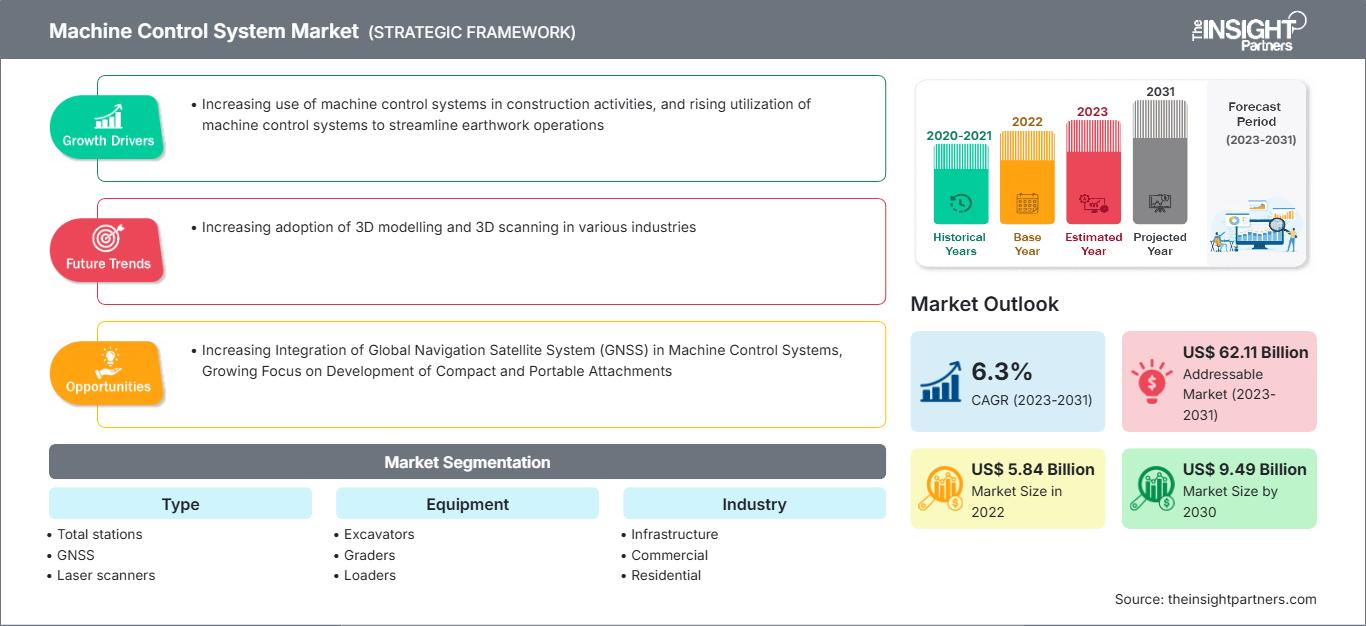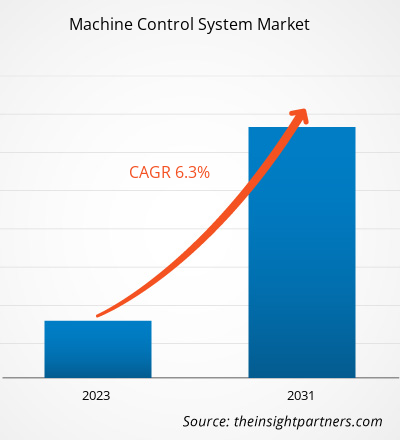预计到 2030 年,机械控制系统市场规模将从 2022 年的 58.4 亿美元增至 94.9 亿美元。预计该市场在 2022 年至 2030 年期间的复合年增长率为 6.3%。各行各业越来越多地采用 3D 建模和 3D 扫描,这很可能仍是市场的主要趋势。
机械控制系统市场分析
自动化技术的兴起为众多终端用户行业采用机械控制系统创造了机会。例如,3D 可视化的广泛应用正在改善建筑行业的运营活动。发达地区商业建筑项目的增加也推动了机械控制系统市场的增长。由于政府和私人组织在商业建筑和基础设施建设方面的投资增加,机械控制系统市场正在增长。建筑工地为成千上万的工人提供了就业机会。安全意识的不断增强,推动了建筑行业对机械控制系统的需求。
机械控制系统市场概览
机械控制系统利用GIS、GNSS和激光扫描等技术扫描工作区域,并准确识别重型土方设备的定位点。土方机械的精确定位能够确保作业的顺利进行,并营造安全无害的工作环境。此外,它还能提高施工和土方作业的准确性和速度,从而提高工作效率。对重型机械导航和控制精度的日益增长的需求预计将推动机械控制系统市场的发展。
通过将现代技术融入其系统,机械控制系统市场的公司正致力于简化系统,提高生产效率。机械控制系统可以最大限度地减少机械和现场故障,同时还能更有效地利用资源。建筑工地的重型机械故障会导致工期延误,并造成巨大的经济损失。机械控制系统能够确保建筑设备得到精确控制和监控,从而最大限度地提高工作现场的效率并加快质量控制。因此,对机器控制系统的投资有助于节省时间、消除项目失败并提高机器安装价格,所有这些都有望在预测期内促进机器控制市场的增长。
自定义此报告以满足您的要求
您将免费获得任何报告的定制,包括本报告的部分内容,或国家级分析、Excel 数据包,以及为初创企业和大学提供超值优惠和折扣
机器控制系统市场: 战略洞察

- 获取本报告的主要市场趋势。这个免费样本将包括数据分析,从市场趋势到估计和预测。
您将免费获得任何报告的定制,包括本报告的部分内容,或国家级分析、Excel 数据包,以及为初创企业和大学提供超值优惠和折扣
机器控制系统市场: 战略洞察

- 获取本报告的主要市场趋势。这个免费样本将包括数据分析,从市场趋势到估计和预测。
机械控制系统市场驱动因素和机遇
机械控制系统在建筑活动中的应用日益广泛,市场前景看好
过去几年,建筑行业的技术取得了显著进步,而机械控制系统是其中最突出的进步之一。机械控制系统彻底改变了建筑项目的执行方式,因为它们提供了更高的准确性、精确度和效率。此外,机械控制系统利用全球定位系统 (GPS)、传感器、激光和其他先进技术来精确引导和定位重型建筑设备,例如推土机、平地机和挖掘机。机械控制系统为建筑行业提供了更高水平的准确性、效率和安全性。
全球导航卫星系统 (GNSS) 在机械控制系统中的集成度不断提高
全球导航卫星系统是移动性发挥重要作用的应用中不可或缺的一部分。 GNSS 技术正越来越多地融入到挖掘机、推土机、平地机、摊铺机和农用机械等建筑设备中,以提高实时操作的生产率,并为设备操作员提供态势感知信息。因此,全球导航卫星系统 (GNSS) 与机械控制系统的日益集成,为机械控制系统市场的增长提供了丰厚的机遇。
机械控制系统市场报告细分分析
促成机械控制系统市场分析的关键细分领域包括类型、设备、行业、视图类型和交付类型。
- 根据类型,机械控制系统市场可分为全站仪、GNSS、激光扫描仪、机载系统、GIS 采集器等。GNSS 细分市场将在 2022 年占据相当大的市场份额。
- 按设备类型,市场可细分为挖掘机、平地机、装载机、推土机、刮土机、摊铺系统等。 2022 年,挖掘机细分市场占有最大的市场份额。
- 按行业划分,市场分为基础设施、商业、住宅和工业。2022 年,基础设施细分市场占有最大的市场份额。
- 按视图类型划分,市场分为 2D 和 3D。2D 细分市场在 2022 年占有最大的市场份额。
- 按视图类型划分,市场分为 2D 和 3D。2D 细分市场在 2022 年占有最大的市场份额。
- 按交付类型划分,市场分为改造和 OEM 构建。2022 年,OEM 构建细分市场占有最大的市场份额。
按地域划分的机器控制系统市场份额分析
机器控制系统市场报告的地理范围主要分为五个区域:北美、亚太地区、欧洲、中东和非洲以及南非。中美洲。
亚太地区机械控制系统市场细分为澳大利亚、日本、印度尼西亚、新加坡、马来西亚、泰国、菲律宾和新西兰。亚太地区经济强劲增长,对依赖机械控制系统的基础设施建设和多元化项目的需求不断增长。此外,政府对道路建设、桥梁建设和机场扩建等基础设施项目的大规模投资,为机械控制系统销售开辟了新的市场。日本拥有世界上最好的都市基础设施之一。日本政府已于2022年8月批准建造一座新的核电站。值得注意的是,鉴于全球能源危机,新核电站的建设和发展将有助于该国降低对能源进口的依赖。
机械控制系统机器控制系统市场区域洞察
The Insight Partners 的分析师已详尽阐述了预测期内影响机器控制系统市场的区域趋势和因素。本节还讨论了北美、欧洲、亚太地区、中东和非洲以及南美和中美洲的机器控制系统市场细分和地域分布。
机器控制系统市场报告范围
| 报告属性 | 细节 |
|---|---|
| 市场规模 2022 | US$ 5.84 Billion |
| 市场规模 2030 | US$ 9.49 Billion |
| 全球复合年增长率 (2023 - 2031) | 6.3% |
| 历史数据 | 2020-2021 |
| 预测期 | 2023-2031 |
| 涵盖的领域 |
By 类型
|
| 覆盖地区和国家 | 北美
|
| 市场领导者和主要公司简介 |
|
机器控制系统市场参与者密度:了解其对业务动态的影响
机器控制系统市场正在快速增长,这得益于终端用户需求的不断增长,而这些需求的驱动因素包括消费者偏好的不断变化、技术进步以及对产品优势的认知度不断提高。随着需求的增长,企业正在扩展其产品线,不断创新以满足消费者需求,并利用新兴趋势,从而进一步推动市场增长。

- 获取 机器控制系统市场 主要参与者概述
机械控制系统市场新闻及最新发展
机械控制系统市场评估通过收集一手和二手资料后的定性和定量数据进行,这些资料包括重要的公司出版物、协会数据和数据库。机械控制系统市场的一些发展如下:
- 徕卡测量系统推出了徕卡 iCON 工地挖掘机,将机械控制功能引入小型挖掘机,这是一种机械控制解决方案,使小型挖掘机能够轻松准确地执行设计任务。(来源:徕卡测量系统,新闻稿,2022 年 10 月)
- 利勃海尔和徕卡测量系统扩展了履带式挖掘机半自动机械控制系统的产品范围。徕卡测量系统的半自动机械控制系统现已适用于第八代履带式挖掘机型号。 (来源:利勃海尔,新闻稿,2021 年 7 月)
机器控制系统市场报告覆盖范围和交付成果
“机器控制系统市场规模和预测(2020 年–2030 年)”报告对市场进行了详细的分析,涵盖以下领域:
- 机器控制系统市场规模以及涵盖范围内所有关键细分市场的全球、区域和国家/地区预测
- 机器控制系统市场趋势以及市场动态,例如驱动因素、限制因素和关键机遇
- 详细的 PEST/波特五力模型和 SWOT 分析
- 机器控制系统市场分析,涵盖关键市场趋势、全球和区域框架、主要参与者、法规和最新市场发展
- 行业格局和竞争分析,涵盖市场集中度、热图分析、知名参与者和机器控制系统市场的最新发展
- 详细的公司简介
- 历史分析(2 年)、基准年、预测(7 年)及复合年增长率
- PEST和SWOT分析
- 市场规模、价值/数量 - 全球、区域、国家
- 行业和竞争格局
- Excel 数据集
近期报告
相关报告
客户评价
购买理由
- 明智的决策
- 了解市场动态
- 竞争分析
- 客户洞察
- 市场预测
- 风险规避
- 战略规划
- 投资论证
- 识别新兴市场
- 优化营销策略
- 提升运营效率
- 顺应监管趋势






















 获取免费样品 - 机器控制系统市场
获取免费样品 - 机器控制系统市场